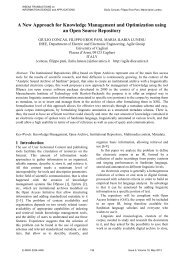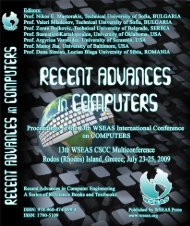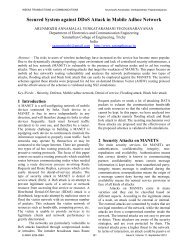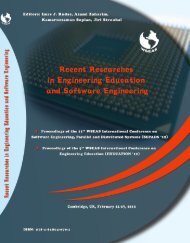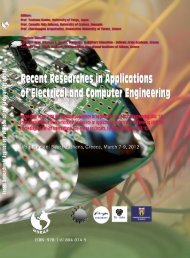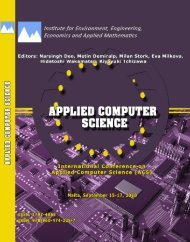Contents of this book - WSEAS
Contents of this book - WSEAS
Contents of this book - WSEAS
Create successful ePaper yourself
Turn your PDF publications into a flip-book with our unique Google optimized e-Paper software.
Recent Advances in Energy, Environment and Economic Development<br />
Plenary Lecture 9<br />
Application <strong>of</strong> Descriptive Statistical and Time Series Analysis on Atmospheric Pollution<br />
Assistant Pr<strong>of</strong>essor Efthimios Zervas<br />
Hellenic Open University<br />
School <strong>of</strong> Science and Technology<br />
Patra, Greece<br />
E-mail: zervas@eap.gr<br />
Abstract: In several scientific fields the results are obtained in the form <strong>of</strong> time series, i.e. the series <strong>of</strong> observations<br />
in constant, or not, time intervals. The analysis <strong>of</strong> time series data can be performed using several statistical<br />
methods. Two <strong>of</strong> these methods are presented here, and their advantages, disadvantages and limitations are<br />
compared and discussed. The first one uses four descriptive statistical measures: mean value, standard deviation,<br />
skewness and kurtosis <strong>of</strong> the data distribution. Those measures can be applied on different time frames, such as<br />
annual period, monthly, weekly, daily, etc. The second method uses the time series analysis. More specifically, the<br />
time series is represented by a dynamic model (model ARIMA, process Box&Jenkins), where each observation is<br />
considered as a function <strong>of</strong> the past values. The Box–Jenkins (ARIMA) method first analyses the time series in order<br />
to find its trend, its periodicity, its constant term and its noise. In a second part, the time series is transformed to<br />
stationary one (without trend and periodicity), by appropriate data transformation. The combination <strong>of</strong> the moving<br />
average <strong>of</strong> the stationary time series with autoregressive parameters yields to a comprehensive model linking each<br />
value with the previous ones. This model can be used not only to explain the underlying process generating the time<br />
series, but also as a basis for forecasting <strong>of</strong> future values.<br />
The previous two methods, the descriptive statistical analysis and the time series analysis, are applied in the case <strong>of</strong><br />
Athens atmospheric pollutants. Several pollutants measured in different stations and during several years are<br />
analyzed. The results, but also the limitations, <strong>of</strong> the two methods are compared and discussed.<br />
Brief Biography <strong>of</strong> the Speaker:<br />
Efthimios Zervas has a degree <strong>of</strong> Chemical Engineering <strong>of</strong> National Technical University <strong>of</strong> Athens, Greece and a<br />
Ph.D. <strong>of</strong> Institut Français du Pétrole (IFP) and University <strong>of</strong> Haute Alsace - France. He worked for several years in<br />
Renault in the field <strong>of</strong> emission control and development <strong>of</strong> after-treatment devices. In 2006 he moved as Assistant<br />
Pr<strong>of</strong>essor in the Department <strong>of</strong> Environmental Engineering <strong>of</strong> Democritus University <strong>of</strong> Thrace and in September<br />
2009 he moved in Hellenic Open University. His scientific interests are in the fields <strong>of</strong> atmospheric pollution, control <strong>of</strong><br />
pollutants emitted from combustion systems, development and use <strong>of</strong> alternative fuels, energy and environmental<br />
policy and economics. He is author <strong>of</strong> more than 50 publications in international scientific journals, has more than 70<br />
presentations in conferences, is referee <strong>of</strong> more than 130 papers <strong>of</strong> international scientific journals and has more<br />
than 600 citations.<br />
ISBN: 978-1-61804-139-5 23




